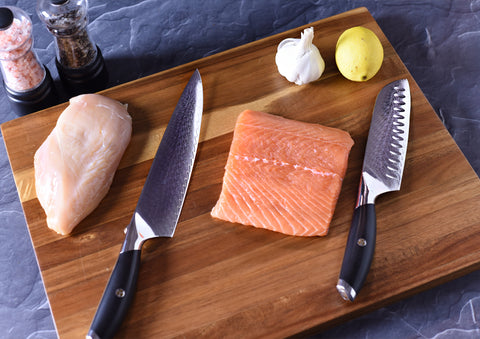Understanding how to hold a santoku knife is crucial for professional and home chefs. This versatile kitchen tool, originating from Japan, is designed for precise slicing, dicing, and chopping. In this comprehensive guide, we will delve into the proper techniques and considerations for holding a santoku knife safely and efficiently.

The Importance of Proper Knife Grip
Having the right grip on your santoku knife is vital. It not only enhances your cutting efficiency but also ensures your safety. A proper grip reduces the risk of slipping, which can lead to accidents. Let’s explore the fundamentals of gripping a santoku knife.
Why Grip Matters
A good grip maximizes your control over the blade, making your food preparation tasks more efficient. Moreover, it decreases hand fatigue during prolonged use. To truly reap these benefits, you’ll need to master the correct grip technique.

Types of Grips for a Santoku Knife
There are several ways to hold a santoku knife, each serving different purposes depending on what you’re cutting. The two primary grips are the pinch grip and the handle grip.
The Pinch Grip
The pinch grip is often recommended by professional chefs. It provides optimal control and precision, making it perfect for tasks that require exact cuts. Heres how to do it:
- Pinch the blade between your thumb and forefinger, right where the blade meets the handle.
- Wrap your remaining three fingers around the handle.
This grip might feel awkward at first, but it offers the most control.
The Handle Grip
The handle grip is another common way to hold a santoku knife. Its easier for beginners and involves simply wrapping your hand around the handle. Heres how:
- Hold the handle with all your fingers.
- Make sure your hand is snug against the bolster.
This grip is more comfortable for extended use but offers slightly less control than the pinch grip.

Using a Santoku Knife Safely
Safety should always be your top priority in the kitchen. Here are some essential safety tips:
Keep Your Knife Sharp
A sharp knife is safer than a dull one. It requires less force to cut through food, decreasing the risk of slipping and cutting yourself. Learn more about keeping your knife sharp here.
Mind Your Fingers
Always be aware of where your fingers are in relation to the blade. Use the claw grip for your non-dominant hand to hold the food. This grip involves curling your fingers inward, keeping your fingertips safe from the blade.
Use a Cutting Board
Always use a sturdy cutting board to provide a stable surface for cutting. A non-slip board is best to prevent the board from moving around while you’re cutting.

Common Mistakes to Avoid
Even seasoned chefs can make mistakes. Here are some common ones to avoid:
Gripping Too Tightly
Holding the knife too tightly can cause hand fatigue and reduce your control over the blade. A relaxed grip allows for better precision and control.
Not Using the Entire Blade
Many people tend to use just the tip or middle of the blade. The santoku knife is designed for rocking cuts, so make sure to use the entire blade for efficient chopping.
Improper Maintenance
Keeping your knife in top condition is crucial. Regularly hone and sharpen your santoku knife to maintain its efficiency. Don’t forget to store it properly to avoid damage.
Choosing the Right Santoku Knife
Not all santoku knives are created equal. Heres what to look for when selecting one:
Blade Material
High-quality steel blades are durable and maintain their sharp edge longer. Look for knives made from high-carbon stainless steel.
Handle Comfort
The handle should be comfortable to hold, offering a secure grip. Consider options with ergonomic designs to reduce hand fatigue.
Weight and Balance
The knife should have a balanced weight, making it easy to maneuver. Hold the knife before purchasing to feel its balance and weight.
FAQs
1. How should I maintain my santoku knife?
Regularly hone and sharpen the blade. Clean it immediately after use and store it properly to avoid damage. For more details on knife maintenance, check out this guide.
2. What is the primary use of a santoku knife?
A santoku knife is primarily used for slicing, dicing, and chopping. Its design allows for precise cuts, making it a versatile tool in the kitchen.
3. Can I use a santoku knife for meat?
Yes, a santoku knife can be used for cutting meat, but its best suited for slicing boneless meat. For handling bones, a heavier knife like a cleaver is more appropriate.
As an Amazon Associate, I earn from qualifying purchases.
As an Amazon Associate, I earn from qualifying purchases.

